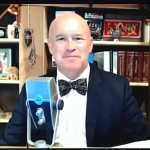Dailygalaxy
June 1, 2011
Like many physicists, Michio Kaku thinks our universe will end in a “big freeze.” However, unlike many physicists, he thinks we might be able to avoid this fate by slipping into a parallel universe. “i
One of the most fascinating discoveries of our new century may be imminent if the Large Hadron Collider outside Geneva produces nano-blackholes when it goes live again. According to the best current physics, such nano blackholes could not be produced with the energy levels the LHC can generate, but could only come into being if a parallel universe were providing extra gravitational input. Versions of multiverse theory suggest that there is at least one other universe very close to our own, perhaps only a millimeter away. This makes it possible that some of the effects, especially gravity, “leak through,” which could be responsible for the production of dark energy and dark matter that make up 96% of the universe.
“The multiverse is no longer a model, it is a consequence of our models,” says Aurelien Barrau, particle physicist at CERN
While it hasn’t been proven yet, many highly respected and credible scientists are now saying there’s reason to believe that parallel dimensions could very well be more than figments of our imaginations.
“The idea of multiple universes is more than a fantastic invention—it appears naturally within several scientific theories, and deserves to be taken seriously,” stated Aurelien Barrau, a French particle physicist at the European Organization for Nuclear Research (CERN).
There are a variety of competing theories based on the idea of parallel universes, but the most basic idea is that if the universe is infinite, then everything that could possibly occur has happened, is happening, or will happen.
According to quantum mechanics, nothing at the subatomic scale can really be said to exist until it is observed. Until then, particles occupy uncertain “superposition” states, in which they can have simultaneous “up” and “down” spins, or appear to be in different places at the same time. The mere act of observing somehow appears to “nail down” a particular state of reality. Scientists don’t yet have a perfect explanation for how it occurs, but that hasn’t changed the fact that the phenomenon does occur.
Unobserved particles are described by “wave functions” representing a set of multiple “probable” states. When an observer makes a measurement, the particle then settles down into one of these multiple options, which is somewhat how the multiple universe theory can be explained.
The existence of such a parallel universe “does not even assume speculative modern physics, merely that space is infinite and rather uniformly filled with matter as indicated by recent astronomical observations,” Max Tegmark, a cosmologist at MIT in Boston, Massachusetts concluded in a study of parallel universes published by Cambridge University.
Mathematician Hugh Everett published landmark paper in 1957 while still a graduate student at Princeton University. In this paper he showed how quantum theory predicts that a single classical reality will gradually split into separate, but simultaneously existing realms.
“This is simply a way of trusting strictly the fundamental equations of quantum mechanics,” says Barrau. “The worlds are not spatially separated, but exist as kinds of ‘parallel’ universes.”
Partly because the idea is so uncomfortably strange, it’s dismissed as sci-fi by many critics. But there are also many credible, respected proponents of the theory—a group that is continuously gaining new adherents as new research unveils new evidence. Some Oxford research—for the first time—recently found a mathematical answer that sweeps away one of the key objections to the controversial idea. Their research shows that Everett was indeed on the right track when he came up with his multiverse theory. The Oxford team, led by Dr David Deutsch, showed mathematically that the bush-like branching structure created by the universe splitting into parallel versions of itself can explain the probabilistic nature of quantum outcomes.
But if parallel worlds do exist, there is a way around these troublesome paradoxes. Deutsch argues that time travel shifts happen between different branches of reality. The mathematical breakthrough bolsters his claim that quantum theory does not forbid time travel. “It does sidestep it. You go into another universe,” he said. But he admits that there will be a lot of work to do before we can manipulate space-time in a way that makes “hops” possible. While it may sound fanciful, Deutsch says that scientific research is continually making the theory more believable.
“Many sci-fi authors suggested time travel paradoxes would be solved by parallel universes but in my work, that conclusion is deduced from quantum theory itself.”
The borderline between physics and metaphysics is not defined by whether an entity can be observed, but whether it is testable, insists Tegmark.
He points to phenomena such as black holes, curved space, the slowing of time at high speeds, even a round Earth, which were all once rejected as scientific heresy before being proven through experimentation, even though some remain beyond the grasp of observation. It is likely, Tegmark concludes that multiverse models grounded in modern physics will eventually be empirically testable, predictive and disprovable.









Add comment